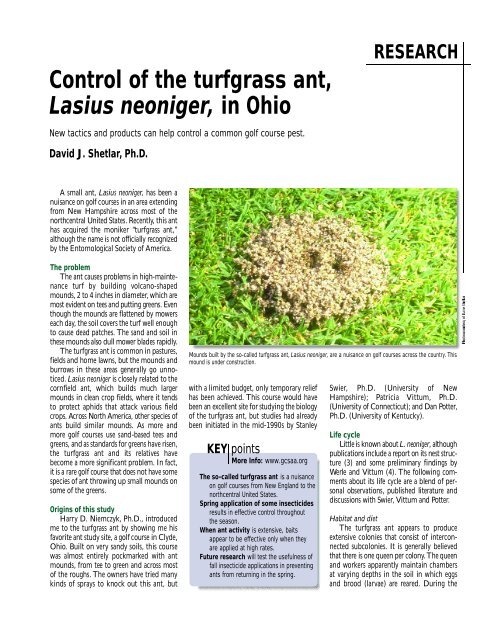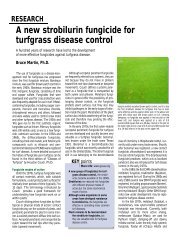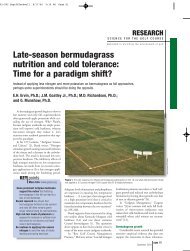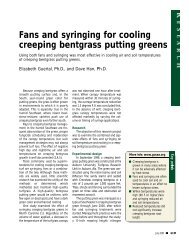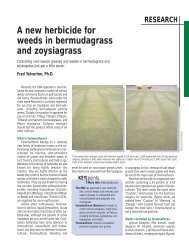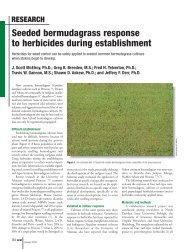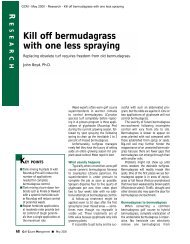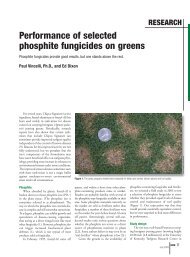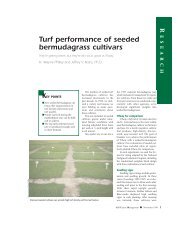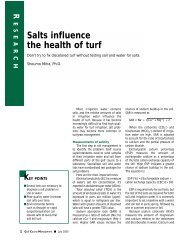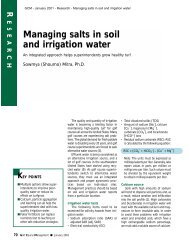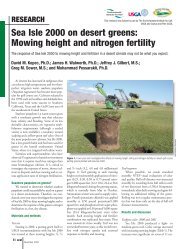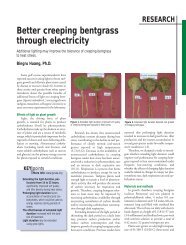Control of the turfgrass ant, Lasius neoniger, in Ohio - GCSAA
Control of the turfgrass ant, Lasius neoniger, in Ohio - GCSAA
Control of the turfgrass ant, Lasius neoniger, in Ohio - GCSAA
Create successful ePaper yourself
Turn your PDF publications into a flip-book with our unique Google optimized e-Paper software.
<strong>Control</strong> <strong>of</strong> <strong>the</strong> <strong>turfgrass</strong> <strong>ant</strong>,<br />
<strong>Lasius</strong> <strong>neoniger</strong>, <strong>in</strong> <strong>Ohio</strong><br />
New tactics and products can help control a common golf course pest.<br />
RESEARCH<br />
David J. Shetlar, Ph.D.<br />
A small <strong>ant</strong>, <strong>Lasius</strong> <strong>neoniger</strong>, has been a<br />
nuisance on golf courses <strong>in</strong> an area extend<strong>in</strong>g<br />
f rom New Ha m p s h i re across most <strong>of</strong> <strong>the</strong><br />
n o rthcentral United States. Re c e n t l y, this <strong>ant</strong><br />
has acquired <strong>the</strong> moniker “t u rfgrass <strong>ant</strong>,”<br />
although <strong>the</strong> name is not <strong>of</strong>ficially re c o g n i ze d<br />
by <strong>the</strong> Entomological Society <strong>of</strong> America.<br />
The problem<br />
The <strong>ant</strong> causes problems <strong>in</strong> high-ma<strong>in</strong>tenance<br />
turf by build<strong>in</strong>g vo l c a n o - s h a p e d<br />
mounds, 2 to 4 <strong>in</strong>ches <strong>in</strong> diameter, which are<br />
most evident on tees and putt<strong>in</strong>g greens. Eve n<br />
though <strong>the</strong> mounds are flattened by mowe r s<br />
each day, <strong>the</strong> soil covers <strong>the</strong> turf well enough<br />
to cause dead patches. The sand and soil <strong>in</strong><br />
<strong>the</strong>se mounds also dull mower blades rapidly.<br />
The <strong>turfgrass</strong> <strong>ant</strong> is common <strong>in</strong> pasture s ,<br />
fields and home lawns, but <strong>the</strong> mounds and<br />
b u r rows <strong>in</strong> <strong>the</strong>se areas generally go unnoticed.<br />
<strong>Lasius</strong> <strong>neoniger</strong> is closely related to <strong>the</strong><br />
cornfield <strong>ant</strong>, which builds much larger<br />
mounds <strong>in</strong> clean crop fields, where it tends<br />
to protect aphids that attack various field<br />
c rops. Ac ross No rth America, o<strong>the</strong>r species <strong>of</strong><br />
<strong>ant</strong>s build similar mounds. As more and<br />
m o re golf courses use sand-based tees and<br />
g reens, and as standards for greens have risen,<br />
<strong>the</strong> <strong>turfgrass</strong> <strong>ant</strong> and its re l a t i ves have<br />
become a more signific<strong>ant</strong> problem. In fact,<br />
it is a rare golf course that does not have some<br />
species <strong>of</strong> <strong>ant</strong> throw<strong>in</strong>g up small mounds on<br />
some <strong>of</strong> <strong>the</strong> gre e n s .<br />
Orig<strong>in</strong>s <strong>of</strong> this study<br />
Ha r ry D. Niemczyk, Ph.D., <strong>in</strong>tro d u c e d<br />
me to <strong>the</strong> <strong>turfgrass</strong> <strong>ant</strong> by show<strong>in</strong>g me his<br />
f a vorite <strong>ant</strong> study site, a golf course <strong>in</strong> Clyd e ,<br />
Oh i o. Built on ve ry sandy soils, this course<br />
was almost entirely pockmarked with <strong>ant</strong><br />
mounds, from tee to green and across most<br />
<strong>of</strong> <strong>the</strong> roughs. The owners have tried many<br />
k<strong>in</strong>ds <strong>of</strong> sprays to knock out this <strong>ant</strong>, but<br />
Mounds built by <strong>the</strong> so-called <strong>turfgrass</strong> <strong>ant</strong>, <strong>Lasius</strong> <strong>neoniger</strong>, are a nuisance on golf courses across <strong>the</strong> country. This<br />
mound is under construction.<br />
with a limited budget, only temporary re l i e f<br />
has been achieved. This course would have<br />
been an excellent site for study<strong>in</strong>g <strong>the</strong> biology<br />
<strong>of</strong> <strong>the</strong> <strong>turfgrass</strong> <strong>ant</strong>, but studies had alre a d y<br />
been <strong>in</strong>itiated <strong>in</strong> <strong>the</strong> mid-1990s by St a n l e y<br />
KEY po<strong>in</strong>ts<br />
More Info: www.gcsaa.org<br />
The so-called <strong>turfgrass</strong> <strong>ant</strong> is a nuisance<br />
on golf courses from New England to <strong>the</strong><br />
northcentral United States.<br />
Spr<strong>in</strong>g application <strong>of</strong> some <strong>in</strong>secticides<br />
results <strong>in</strong> effective control throughout<br />
<strong>the</strong> season.<br />
When <strong>ant</strong> activity is extensive, baits<br />
appear to be effective only when <strong>the</strong>y<br />
are applied at high rates.<br />
Future research will test <strong>the</strong> usefulness <strong>of</strong><br />
fall <strong>in</strong>secticide applications <strong>in</strong> prevent<strong>in</strong>g<br />
<strong>ant</strong>s from return<strong>in</strong>g <strong>in</strong> <strong>the</strong> spr<strong>in</strong>g.<br />
Sw i e r, Ph.D. (Un i versity <strong>of</strong> New<br />
Ha m p s h i re); Patricia Vittum, Ph . D .<br />
( Un i versity <strong>of</strong> Connecticut); and Dan Po t t e r,<br />
Ph.D. (Un i versity <strong>of</strong> Ke n t u c k y ) .<br />
Life cycle<br />
Little is known about L. <strong>neoniger</strong>, although<br />
publications <strong>in</strong>clude a re p o rt on its nest stru c-<br />
t u re (3) and some pre l i m i n a ry f<strong>in</strong>d<strong>in</strong>gs by<br />
Werle and Vittum (4). The follow<strong>in</strong>g comments<br />
about its life cycle are a blend <strong>of</strong> personal<br />
observations, published literature and<br />
discussions with Sw i e r, Vittum and Po t t e r.<br />
Habitat and diet<br />
The <strong>turfgrass</strong> <strong>ant</strong> appears to pro d u c e<br />
e x t e n s i ve colonies that consist <strong>of</strong> <strong>in</strong>terc o n-<br />
nected subcolonies. It is generally believe d<br />
that <strong>the</strong>re is one queen per colony. The queen<br />
and workers apparently ma<strong>in</strong>ta<strong>in</strong> chambers<br />
at va ry<strong>in</strong>g depths <strong>in</strong> <strong>the</strong> soil <strong>in</strong> which eggs<br />
and brood (larvae) are re a red. Dur<strong>in</strong>g <strong>the</strong>
RESEARCH<br />
s u m m e r, additional chambers near <strong>the</strong> soil<br />
s u rface are constructed, and each <strong>of</strong> <strong>the</strong>se<br />
chambers may have an open<strong>in</strong>g to <strong>the</strong> outside<br />
and an associated mound. T h e re f o re, a<br />
colony may have one major open<strong>in</strong>g and<br />
n u m e rous satellite open<strong>in</strong>gs, each with its<br />
associated mound <strong>of</strong> soil.<br />
This <strong>ant</strong> seems to feed on all k<strong>in</strong>ds <strong>of</strong><br />
food: fats, prote<strong>in</strong>s and sugars (2).<br />
T h e re f o re, <strong>the</strong> <strong>ant</strong>s eat o<strong>the</strong>r <strong>in</strong>sects (fats and<br />
p rote<strong>in</strong>s) and ma<strong>in</strong>ta<strong>in</strong> honeyd ew - p ro d u c-<br />
<strong>in</strong>g <strong>in</strong>sects (sugar producers). A student <strong>of</strong><br />
Potter has recently confirmed a close association<br />
between <strong>the</strong> <strong>turfgrass</strong> <strong>ant</strong> and ro o t -<br />
<strong>in</strong>fest<strong>in</strong>g (soil) aphids (1).<br />
Reproduction<br />
An <strong>in</strong>terest<strong>in</strong>g paper published by a<br />
USDA <strong>ant</strong> re s e a rcher <strong>in</strong> <strong>the</strong> 1930s (fro m<br />
C l yde, <strong>Ohio</strong>) re p o rted that <strong>the</strong> <strong>ant</strong> seems to<br />
p roduce one major brood after open<strong>in</strong>g its<br />
nests <strong>in</strong> <strong>the</strong> spr<strong>in</strong>g. The queen steps up egg<br />
p roduction when food beg<strong>in</strong>s to flow <strong>in</strong>to <strong>the</strong><br />
nest. The brood from this peak egg pro d u c-<br />
tion develop ra<strong>the</strong>r slowly through Ma y, Ju n e<br />
and Ju l y. New adult workers (all female)<br />
beg<strong>in</strong> to appear <strong>in</strong> Ju l y, and mound pro l i f e r-<br />
ation <strong>in</strong>creases dramatically. These work e r s<br />
cont<strong>in</strong>ue to collect food dur<strong>in</strong>g <strong>the</strong> summer<br />
months, apparently stor<strong>in</strong>g <strong>the</strong> re s e rves <strong>in</strong> <strong>the</strong><br />
nest <strong>in</strong> <strong>ant</strong>icipation <strong>of</strong> lean periods. W h e n<br />
colonies have matured, a considerable percentage<br />
<strong>of</strong> <strong>the</strong> brood develops <strong>in</strong>to a new<br />
batch <strong>of</strong> w<strong>in</strong>ged re p ro d u c t i ves (queens and<br />
d rones). The re p ro d u c t i ve cast consists <strong>of</strong><br />
The <strong>turfgrass</strong> <strong>ant</strong> is closely associated with root-<strong>in</strong>fest<strong>in</strong>g (soil) aphids.<br />
much larger <strong>in</strong>dividuals that generally do not<br />
m a t u re until late July and August.<br />
On warm afternoons, <strong>of</strong>ten after re c e n t<br />
ra<strong>in</strong>s, <strong>the</strong> new queens and drones swarm by<br />
<strong>the</strong> thousands, and all colonies <strong>in</strong> an are a<br />
commonly release <strong>the</strong>se w<strong>in</strong>ged forms at <strong>the</strong><br />
same time. Dur<strong>in</strong>g <strong>the</strong>se events, <strong>the</strong> <strong>ant</strong>s can<br />
become nuisances around lights at night.<br />
New queens are about five times <strong>the</strong> body<br />
weight <strong>of</strong> a worker or w<strong>in</strong>ged males. Like<br />
most <strong>ant</strong>s, <strong>the</strong> new queens and drones mate<br />
while fly<strong>in</strong>g, and once <strong>the</strong> nuptial flight is<br />
completed, <strong>the</strong> female seeks a new place to<br />
build a chamber. Upon land<strong>in</strong>g on <strong>the</strong><br />
g round, <strong>the</strong> queen chews <strong>of</strong>f her w<strong>in</strong>gs and<br />
builds a small chamber <strong>in</strong> <strong>the</strong> soil, <strong>of</strong>ten<br />
t h row<strong>in</strong>g up a small mound <strong>of</strong> soil that may<br />
be 3 ⁄8- to 1 ⁄2-<strong>in</strong>ch <strong>in</strong> diameter. The chamber is<br />
usually only an <strong>in</strong>ch deep. Most queens die<br />
b e f o re mak<strong>in</strong>g chambers, and <strong>the</strong> ones that<br />
successfully dig a burrow appear to die fro m<br />
p redation or o<strong>the</strong>r causes with<strong>in</strong> a week or<br />
t w o. Queens that surv i ve <strong>in</strong> constru c t e d<br />
chambers lay a small batch <strong>of</strong> eggs, and <strong>the</strong><br />
l a rvae that develop are fed regurgitated food<br />
that appears to come from fat and w<strong>in</strong>g muscle<br />
reabsorbed by <strong>the</strong> queen.<br />
With<strong>in</strong> six weeks, <strong>the</strong> small batch <strong>of</strong> new<br />
w o rker <strong>ant</strong>s (which are <strong>of</strong>ten half <strong>the</strong> size <strong>of</strong><br />
normal workers) break open <strong>the</strong> brood cham-<br />
ANTS VS. INSECTICIDES, 2000<br />
Rate<br />
Active mounds/square yard (% reduction) ‡<br />
Treatment † (pound ai/acre) 1 WAT 2 WAT 4 WAT 8 WAT 12 WAT 21 WAT<br />
Talstar 0.2G 0.20 2.4 ef (87) 7.3 cd (46) 10.5 a (26) 10.1 ab (0) 10.8 a (0) 5.9 a (2)<br />
Fipronil 0.0143G § 0.0125 12.3 ab (22) 10.9 a (19) 12.9 a (10) 7.5 bc (6) 4.8 bc (22) 2.1 b (65)<br />
Fipronil 0.0143G 0.025 10.6 bc (37) 11.0 abc (18) 11.1 a (22) 6.4 c (20) 2.3 cd (63) 0.8 b (88)<br />
Merit 75WP 0.40 11.1 abc (11) 8.9 bc (34) 5.8 b (60) 0.3 d (97) 0.1 d (98) 2.4 b (60)<br />
Meridian 25WG 0.26 5.6 de (60) 3.0 de (78) 0.8 c (95) 0.1 d (98) 0.1 d (98) 2.0 b (67)<br />
Meridian 25WG + 0.26<br />
Scimitar 0.88GC 0.06 0.4 f (98) 0.0 e (100) 1.4 bc (90) 0.5 d (94) 0.6 d (90) 1.3 b (79)<br />
Check 14.8 a 13.4 ab 14.3 a 8.0 bc 6.4 b 6.0 a<br />
†<br />
‡<br />
Treatments applied May 17,2000,to plots 10 by 15 feet,replicated four times.No irrigation after treatment.<br />
Data taken May 25,June 1,June 15,July13,Aug.10 and Oct.12,based on <strong>the</strong> same central 2 square yard area observed each time with<strong>in</strong> each plot.Means followed by <strong>the</strong> same letter<br />
are not signific<strong>ant</strong>ly different.<br />
§<br />
Fipronil was an experimental <strong>in</strong>secticide at <strong>the</strong> time <strong>of</strong> this treatment.The current product with fipronil as <strong>the</strong> active <strong>in</strong>gredient is Firestar.<br />
Data are shown for <strong>the</strong> efficacy <strong>of</strong> <strong>in</strong>secticides <strong>in</strong> controll<strong>in</strong>g <strong>ant</strong> mounds <strong>of</strong> <strong>Lasius</strong> <strong>neoniger</strong> (Emery) one to 21 weeks after treatment (WAT) on a golf course fairway at<br />
Crockett’s Green Hills Golf Course,Clyde,<strong>Ohio</strong>.Data are for <strong>the</strong> 2000 season.
e r, forage for food and help feed ano<strong>the</strong>r<br />
small brood. By this time, w<strong>in</strong>ter has arrive d<br />
and activity <strong>in</strong> new as well as established<br />
colonies ceases. Established colonies and new<br />
colonies that surv i ve <strong>the</strong> w<strong>in</strong>ter resume activity<br />
from late April <strong>in</strong>to early May <strong>in</strong> Oh i o.<br />
Ant control<br />
Suspect<strong>in</strong>g this k<strong>in</strong>d <strong>of</strong> life cyc l e ,<br />
Niemczyk has stated that <strong>the</strong> time to contro l<br />
this <strong>ant</strong> is when <strong>the</strong> mounds first appear <strong>in</strong><br />
<strong>the</strong> spr<strong>in</strong>g. At this time, <strong>the</strong> colonies are at<br />
<strong>the</strong>ir weakest po<strong>in</strong>t: low on food re s e rve s ,<br />
with older workers and few new brood. An<br />
application <strong>of</strong> chlorpyrifos (Dursban) with<strong>in</strong><br />
a week <strong>of</strong> mound appearance <strong>in</strong> <strong>the</strong> spr<strong>in</strong>g<br />
has <strong>of</strong>ten provided four to six weeks <strong>of</strong><br />
mound suppression. Applications made later<br />
<strong>in</strong> <strong>the</strong> season usually suppress mounds for<br />
only two to three we e k s .<br />
In studies <strong>in</strong> <strong>the</strong> 1990s, Niemczyk and I<br />
found that several <strong>of</strong> <strong>the</strong> pry re t h roid <strong>in</strong>secticides<br />
— cyfluthr<strong>in</strong> (Tempo), bifenthr<strong>in</strong><br />
(Talstar), deltamethr<strong>in</strong> (De l t a g a rd), lambdacyhalothr<strong>in</strong><br />
(Scimitar) — provide <strong>the</strong> same<br />
l e vel <strong>of</strong> control as chlorpyrifos, especially if<br />
<strong>the</strong>y are used when mounds first appear.<br />
Later <strong>in</strong> <strong>the</strong> season, do not expect more than<br />
two weeks <strong>of</strong> mound suppre s s i o n .<br />
When imidacloprid (Merit), hal<strong>of</strong>enozide<br />
(MACH2), fipronil (Chipco Choice),<br />
and thiamethoxam (Meridian — not registered<br />
for <strong>turfgrass</strong> usage) were be<strong>in</strong>g developed,<br />
Niemczyk and I began trials to<br />
evaluate how <strong>the</strong>se <strong>in</strong>secticides might <strong>in</strong>fluence<br />
mound build<strong>in</strong>g by L. <strong>neoniger</strong> over an<br />
entire season. We have applied <strong>the</strong>se materials,<br />
at first mound formation <strong>in</strong> <strong>the</strong><br />
RESEARCH<br />
spr<strong>in</strong>g, for nearly five seasons and <strong>the</strong> re s u l t s<br />
have been fairly consistent.<br />
Hal<strong>of</strong>enozide seems to have no measurable<br />
affect on <strong>the</strong> <strong>turfgrass</strong> <strong>ant</strong>. Fi p ro n i l<br />
(ei<strong>the</strong>r as sprays or <strong>the</strong> recently re g i s t e re d<br />
bait) tends to knock down <strong>the</strong> mounds after<br />
two to three weeks, and <strong>of</strong>ten <strong>the</strong> mounds do<br />
not reappear for six to 10 months.<br />
Imidacloprid seems to act ve ry slow l y, with<br />
mound-build<strong>in</strong>g suppression not occurr<strong>in</strong>g<br />
until four to six weeks after <strong>the</strong> <strong>in</strong>itial application.<br />
Howe ve r, once it occurs, mound supp<br />
ression tends to last for <strong>the</strong> rest <strong>of</strong> <strong>the</strong><br />
season, and perhaps <strong>in</strong>to <strong>the</strong> next season.<br />
T h i a m e t h oxam has knocked down <strong>the</strong> <strong>ant</strong><br />
activity <strong>in</strong> only two to three weeks consistently;<br />
<strong>ant</strong>s usually do not return for <strong>the</strong> re s t<br />
<strong>of</strong> <strong>the</strong> season.<br />
Applications <strong>of</strong> imidacloprid and fipro n i l<br />
ANTS VS. INSECTICIDES, 2001<br />
Rate Active mounds/square yard (% reduction) ‡<br />
Treatment † (pound ai/acre) 1 WAT 2 WAT 4 WAT 6 WAT 10 WAT 16 WAT<br />
Talstar 0.2G 0.20 3.84 a (35) 5.8 a (25) 5.1 a (0) 7.4 b (0) 6.4 b (0) 4.1 b (6)<br />
Fipronil 0.0143G § 0.0125 6.0 a (0) 8.3 ab (0) 6.0 a (0) 6.4 b (6) 6.6 b (0) 2.0 ab (55)<br />
Fipronil 0.0143G 0.025 7.9 ab (0) 7.1 a (7) 6.0 a (0) 6.4 b (20) 3.8 ab (32) 0.8 a (83)<br />
Merit 75WP 0.40 11.8 a (0) 13.75 (0) 12.3 b (0) 10.38 b (97) 5.3 b (5) 2.8 ab (37)<br />
Meridian 0.33G 0.26 5.4 a (7) 5.8 a (25) 3.4 a (31) 1.0 a (84) 0.4 a (93) 1.3 a (71)<br />
Check 5.8 a 7.6 ab 4.9 a 6.3 b 5.5 b 4.4 b<br />
†<br />
Treatments applied May 7,2000,to plots 10 by 15 feet replicated four times.No post-treatment irrigation.<br />
‡<br />
Data taken May 14,May 21,June 18,July 2,July 30,and Sept.10 based on <strong>the</strong> same central 2 square yard area observed each time with<strong>in</strong> each plot.Means followed by <strong>the</strong> same letter<br />
are not signific<strong>ant</strong>ly different.<br />
§<br />
Fipronil was an experimental <strong>in</strong>secticide at <strong>the</strong> time <strong>of</strong> this treatment.The current product with fipronil as <strong>the</strong> active <strong>in</strong>gredient is Firestar.<br />
Data are shown for <strong>the</strong> efficacy <strong>of</strong> <strong>in</strong>secticides <strong>in</strong> controll<strong>in</strong>g <strong>ant</strong> mounds <strong>of</strong> <strong>Lasius</strong> <strong>neoniger</strong> (Emery) one to 16 weeks after treatment (WAT) on a golf course fairway at<br />
Crockett’s Green Hills Golf Course,Clyde,<strong>Ohio</strong>.Data are for <strong>the</strong> 2001 season.<br />
FIRESTAR AND MERIDIAN VS. ANTS, 2002<br />
Rate Active mounds/4 square yards (% reduction) ‡<br />
Treatment † (pound ai/acre) 1 WAT 2 WAT 3 WAT 4 WAT 5 WAT 6 WAT 8 WAT<br />
Firestar 0.00015 B 10.0 8.5 bc (79) 6.5 a (53) 2.5 a (38) 6.8 bcd (63) 8.5 abc (53) 7.5 a (3) 13.8 ab (42)<br />
Firestar 0.00015 B 15.0 11.0 bc (73) 6.5 a (53) 2.5 a (38) 6.5 bcd (64) 4.8 bc (74) 4.0 a (48) 9.8 ab (59)<br />
Firestar 0.00015 B 30.0 5.5 c (87) 3.8 a (73) 1.8 a (56) 2.0 cd (89) 1.5 bc (93) 2.0 b (74) 5.3 b (78)<br />
Meridian 0.33 G 0.26 11.0 bc (73) 2.5 a (82) 0.3 a (94) 0.5 d (97) 0.3 c (99) 0.0 b (100) 0.0 b (100)<br />
Check 41.3 a 13.8 a 4.0 a 18.3 a 18.3 a 7.8 a 23.8 a<br />
†<br />
Treatments applied June 24,2002,to plots 15 by 15 feet,replicated four times.No irrigation after treatment.<br />
‡<br />
Data taken July 1,July 8,July 15,July 22,July 29,Aug.5 and Aug.19,based on <strong>the</strong> same central 4-square-yard area observed each time with<strong>in</strong> each plot.Means followed by <strong>the</strong> same<br />
letter are not signific<strong>ant</strong>ly different.<br />
Data are shown for <strong>the</strong> efficacy <strong>of</strong> treatments with Firestar bait and Meridian <strong>in</strong> controll<strong>in</strong>g <strong>ant</strong> mounds <strong>of</strong> <strong>Lasius</strong> <strong>neoniger</strong> (Emery) one to 8 weeks after treatment (WAT) on<br />
a golf course fairway at Crockett’s Green Hills Golf Course,Clyde,<strong>Ohio</strong>.Data are for <strong>the</strong> 2002 season.
RESEARCH<br />
formulations after <strong>the</strong> workers have been forag<strong>in</strong>g<br />
for several weeks have resulted <strong>in</strong> much<br />
less suppression later <strong>in</strong> <strong>the</strong> season. Howe ve r,<br />
f i p ronil baits have signific<strong>ant</strong>ly reduced <strong>ant</strong><br />
mound construction, even <strong>in</strong> midseason.<br />
I believe that <strong>the</strong>ir unique modes <strong>of</strong> action<br />
expla<strong>in</strong> how imidacloprid and fipronil work .<br />
Imidacloprid has been shown to change normal<br />
<strong>in</strong>sect behavior, and an early application<br />
may somehow disrupt <strong>the</strong> rear<strong>in</strong>g <strong>of</strong> <strong>the</strong><br />
b rood, which would expla<strong>in</strong> <strong>the</strong> action<br />
appear<strong>in</strong>g four to six weeks after application.<br />
Fi p ronil is a slow-act<strong>in</strong>g poison and is apparently<br />
picked up by <strong>the</strong> workers, taken back to<br />
<strong>the</strong> colony and fed to o<strong>the</strong>r workers, bro o d<br />
and even <strong>the</strong> queen before <strong>the</strong>y know that<br />
<strong>the</strong>y have been poisoned.<br />
Ant baits<br />
Because Potter and his students (1)<br />
found ve ry good control <strong>of</strong> L. <strong>neoniger</strong> w i t h<br />
h ydramethylnon bait (Ma x f o rce), we<br />
<strong>in</strong>cluded it <strong>in</strong> our studies and compared it<br />
with <strong>the</strong> recently re g i s t e red fipronil <strong>ant</strong> bait<br />
(Firestar). At label rates <strong>of</strong> Maxforce, <strong>ant</strong><br />
mound suppression was m<strong>in</strong>imal, but this<br />
result was similar to results achieved with <strong>the</strong><br />
lower rates <strong>of</strong> Firestar. In fact, high rates <strong>of</strong><br />
both baits were required to get signific<strong>ant</strong><br />
reductions <strong>in</strong> <strong>ant</strong>-mound<strong>in</strong>g activity.<br />
I believe that when ve ry high populations<br />
<strong>of</strong> <strong>the</strong> <strong>turfgrass</strong> <strong>ant</strong> are present, <strong>the</strong> established<br />
bait<strong>in</strong>g rates are not sufficient to supply<br />
enough active <strong>in</strong>gredient to <strong>the</strong> biomass <strong>of</strong><br />
<strong>ant</strong>s <strong>in</strong>vo l ved. In <strong>the</strong>se situations, <strong>the</strong> baits<br />
must be reapplied on a regular basis (possibly<br />
e ve ry two weeks, for three applications), or <strong>the</strong><br />
early-spr<strong>in</strong>g control tactic will have to be used.<br />
W h e re only a few mounds appear on a golf<br />
g reen or tee, application <strong>of</strong> ei<strong>the</strong>r bait over a<br />
small area should knock out <strong>the</strong> <strong>ant</strong>s.<br />
Se verity <strong>of</strong> <strong>the</strong> pro b l e m<br />
Cu r re n t l y, my recommendations for <strong>ant</strong><br />
c o n t rol depend on <strong>the</strong> severity <strong>of</strong> <strong>the</strong> pro b l e m .<br />
For a few occasional mounds, an early application<br />
<strong>of</strong> a pyre t h roid or chlorpyrifos (which is<br />
still available for use on golf courses) followe d<br />
with subsequent applications <strong>of</strong> baits if <strong>the</strong><br />
mounds should return with ei<strong>the</strong>r hyd r a -<br />
methylnon or fipronil-based products should<br />
p rovide satisfactory results. On courses where<br />
large populations <strong>of</strong> this <strong>ant</strong> cause problems on<br />
g reens, tees and fairways re g u l a r l y, an early<br />
application <strong>of</strong> imidacloprid or fipronil should<br />
elim<strong>in</strong>ate <strong>ant</strong> activity for much <strong>of</strong> <strong>the</strong> season.<br />
We have also learned quite a bit about<br />
baits. As has been shown, when baits are used<br />
to control fire <strong>ant</strong>s, <strong>the</strong> <strong>turfgrass</strong> <strong>ant</strong> can be<br />
ra<strong>the</strong>r f<strong>in</strong>icky about <strong>the</strong> quality <strong>of</strong> <strong>the</strong> bait. If<br />
baits are used, be sure to apply <strong>the</strong>m to dry<br />
turf when ra<strong>in</strong>fall is not likely to occur and<br />
irrigation can be withheld for about two days.<br />
Ap p a re n t l y, ra<strong>in</strong> and irrigation render most <strong>of</strong><br />
<strong>the</strong> baits unattractive.<br />
Future research<br />
Di f f e rent control tactics for this <strong>ant</strong> are<br />
be<strong>in</strong>g considered, <strong>in</strong>clud<strong>in</strong>g application <strong>of</strong> imidacloprid,<br />
thiamethoxam or fipronil when <strong>the</strong><br />
n ew queens establish colonies <strong>in</strong> Se p t e m b e r.<br />
The thought beh<strong>in</strong>d this method is that <strong>the</strong> <strong>ant</strong><br />
colonies would take <strong>in</strong> enough material dur<strong>in</strong>g<br />
<strong>the</strong> fall to lower <strong>the</strong>ir w<strong>in</strong>ter surv i val, and <strong>ant</strong><br />
colonies elim<strong>in</strong>ated <strong>in</strong> <strong>the</strong> fall and w<strong>in</strong>ter<br />
should not reappear <strong>the</strong> follow<strong>in</strong>g spr<strong>in</strong>g.<br />
Acknowledgments<br />
We thank Bob Crockett, owner <strong>of</strong> Crockett’s Green<br />
Hills Golf Course, C ly d e ,O h i o , for allow<strong>in</strong>g us to use his golf<br />
course <strong>in</strong> our studies.<br />
References<br />
1. L o p e z , R ., D . W. Held and D.A. Po t t e r. 2000 .<br />
Management <strong>of</strong> a mound-build<strong>in</strong>g <strong>ant</strong>, <strong>Lasius</strong><br />
<strong>neoniger</strong> Emery, on golf putt<strong>in</strong>g greens us<strong>in</strong>g<br />
delayed action baits <strong>of</strong> fipronil. Crop Science 40:<br />
511-517.<br />
2. Traniello, T.F.A.1983.Social organization and forag<strong>in</strong>g<br />
success <strong>of</strong> <strong>Lasius</strong> <strong>neoniger</strong> (Hymenoptera:<br />
Formicidae):behavioral and ecological aspects <strong>of</strong><br />
recruitment communication. Oecologica 59:94-<br />
100.<br />
3. Wang, D., K. McSweeney, B. Lowery and J.M.<br />
Norman. 1995. Nest structure <strong>of</strong> <strong>the</strong> <strong>ant</strong> <strong>Lasius</strong><br />
<strong>neoniger</strong> Emery and its implications on soil modification.<br />
Geoderma 66:259-272.<br />
4. Werle, S.F., and P.J. Vittum. 1999. The <strong>turfgrass</strong><br />
a n t : a necessary nuisance Golf Course<br />
Management 67:49-52.<br />
David J.Shetlar, Ph.D.(shetlar.1@osu.edu),is an associate<br />
pr<strong>of</strong>essor <strong>of</strong> entomology at <strong>Ohio</strong> State University,<br />
Columbus.<br />
CURATIVE TREATMENTS, 2001<br />
Rate (pound<br />
Active mounds/square yard (% reduction) ‡<br />
Treatment † ai/acre) 1 WAT 2 WAT 4 WAT 6 WAT 8 WAT 11 WAT<br />
Meridian 25WG 0.26 5.63 bc (29) 4.6 ab (53) 2.2 a (69) 1.9 a (74) 3.6 a (67) 3.2 a (57)<br />
Tempo Ultra SC 0.07 9.44 c (0) 11.8 c (0) 10.1 cd (0) 8.0 c (0) 13.7 c (0) 9.1 cd (0)<br />
Dursban Pro 2EC 1.5 1.5 a (81) 3.2 a (68) 5.8 abc(18) 5.6 abc(22) 9.6 bc (15) 7.9 bcd (0)<br />
DeltaGard 0.42F 0.13 9.0 c (0) 10.4 c (0) 11.0 d (0) 6.6 bc (8) 12.8 c (0) 9.0 cd (0)<br />
Talstar 0.67F 0.20 3.3 ab (58) 10.0 c (0) 3.4 a (31) 9.1 c (0) 12.6 c (0) 11.3 d (0)<br />
Firestar Bait 0.000225 5.7 bc (28) 8.8 bc (11) 9.3 cd (0) 6.9 bc (4) 10.9 bc (4) 8.5 cd (0)<br />
Firestar Bait 0.00225 1.25 a (84) 2.2 a (78) 4.0 ab (44) 3.6 ab (50) 6.8 ab (41) 4.7 ab (38<br />
Check 7.9 a 9.8 c 7.1 d 7.2 bc 11.4 bc 7.4 bc<br />
†<br />
Treatments applied June 18,2001,to plots 10 by 15 feet replicated four times.No irrigation after treatment.<br />
‡<br />
Data taken June 25,July 2,July 16,July 30,Aug.13 and Sept.10,based on <strong>the</strong> same central 2-square-yard area observed each time with<strong>in</strong> each plot.Means followed by <strong>the</strong> same letter<br />
are not signific<strong>ant</strong>ly different.<br />
Data are shown for <strong>the</strong> efficacy <strong>of</strong> <strong>in</strong>secticides <strong>in</strong> controll<strong>in</strong>g <strong>ant</strong> mounds <strong>of</strong> <strong>Lasius</strong> <strong>neoniger</strong> (Emery) one to 11 weeks after treatment (WAT) on a golf course fairway at<br />
Crockett’s Green Hills Golf Course,Clyde,<strong>Ohio</strong>.Data are for <strong>the</strong> 2001 season.


